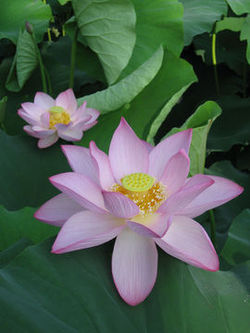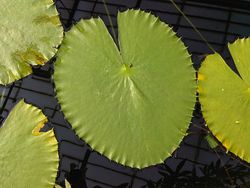Waterlily
| Waterlily |
|---|

|
| Scientific Classification |
|
| Species |
|
| Image Description |
Nymphaeales is the scientific name for lily pad , waterlilys. There is so many other types of water lilys under the scientific name Nymphaeales.
the waterlily has a dark purple and reddish tone to it. its about 2 to 6 inches across. It a flower and flower has petals witch are white. The stem goes all way to the bottom of the ground.It opens very early in the morning and closes at noon
Life Cycle
The life cycle of the waterlily, Nymphaea is another name for water lily so if you ever hear the name Nymphaea its the water lily.The first step to this cycle is reproduction, in this stage the flower will begin to bloom or in bloom . In the middle of the flower is fluid witch contains the female reproductive organs. If a nd when an insect comes to the middle of the flower it will get stuck cause of its sticky. it will then take off the pollen thats left of the insect. If it is not an insect then the stickiness will dry up and the pollen is released in its place. After that when the flower is pollinated the flower and the stem will sink down in to the water and become a berrylike fruit will grow. the waterlily contains seeds that are underwater in this spongy berry fruit. Eventually when the fruit ripens it will release about 2,000 of seed all over the pond. These seeds then will absorb the water then they will slowly sink to the bottom of the pond.They will dig themselves in the mud , after that the rhizomes will begin to grow. Shortly after that the stem will grow from the rhizomes and rise to the surface of the water. It will reproduce a leaf that is flat, round an dater replenant.
On the opposite side of the leaf the colors are dark purple or red. Witch allows the plant maximum to utilize photosynthesis. The leafs stem works to transport air to the surface downy to the rhizomes. Every single stem will create a flower thats about 2 to 6 inches across. Then it blossoms early in the morning the at noon its closes.
Ecology
Waterlily tend to be found in sluggish streams or rivers ponds (ect.) The reagent water lily is a perennial, floating mostly found in 3 to 6 feet of water. it mostly grows in fresh lakes ponds or slow streaming rivers. the water lily prefers mucky muddy environment. This plant spread quickly one rhizomes can cover up 15 feet diameter circle in five years. Since they cover up so much and can use up a lot of room sadly more drawings have been happening cause of theses water lilys. it also prevents boats from going in the water lilies if the boat has a moter. Normally the water lily grows to June to October. After it fertilizes it curls up like a cork screw, then seed float up to the surface of the water and spread through the water movement. It has a thick rhizomes and can spread vegetatively and will rhizomes fragments break off. in the fall it decays and sits up ion the surface. One way you can help is not to purposefully plant a waterlily in a pond or river that people use a lot. A small patch of water can be dug up underwater at a time to get rid of them. If you wanted it to be bigger area you would ave to go under the water and get the root shut then cut by hand the stems and leaves. But when you do this it will take a while cause you can use tools and all that jazz but it will take about 3 years to do if you did that retentively. That being said it is a beautiful plant until it becomes harmful to our environment.
Video


